- Log in
-
- Sydney Overseas Office
- London Overseas Office
- Toronto Overseas Office
- Los Angeles Overseas Office
- New York Overseas Office
- Ulaanbaatar Overseas Office
- Dubai Overseas Office
- New Delhi Overseas Office
- Manila Overseas Office
- Jakarta Overseas Office
- Hanoi Overseas Office
- Kuala Lumpur Overseas Office
- Singapore Overseas Office
- Bangkok Overseas Office
- Map
- Sydney Overseas Office
- London Overseas Office
- Toronto Overseas Office
- Los Angeles Overseas Office
- New York Overseas Office
- Ulaanbaatar Overseas Office
- Dubai Overseas Office
- New Delhi Overseas Office
- Manila Overseas Office
- Jakarta Overseas Office
- Hanoi Overseas Office
- Kuala Lumpur Overseas Office
- Singapore Overseas Office
- Bangkok Overseas Office
Contents View
-
-
-
Minimizes Damage to the Egg’s Cytoplasm Using Micro-Electric Vibration
-
11/17/2022
709
-
0
0
-
-
Gyeonggi-do
Goyang
Obstetrics_and_Gynecology
Korea_Medical_Tourism
Recommended_Hospitals
-
-
-
CHA University Ilsan Medical Center Introduces Piezo ICSI, for the First Time in Korea
Two Out of Ten Married Couples Are Infertile

Infertility is when a healthy couple of childbearing age cannot conceive even after a year of regular unprotected sex. Usually, 70-80% of couples who have sex without contraception become pregnant within one year, and 80-90% naturally become pregnant within two years. But in the modern era, two out of ten married couples suffer from infertility for various reasons.
As pregnancy is a very delicate process, infertility can be caused by various reasons, so a rather complex approach is required to find the cause. Of course, infertility is most frequently caused by physical defects in the man or woman, but recently, lifestyle and social factors have emerged as crucial factors as well. In other words, health imbalances caused by repeated stress and social trends sometimes cause problems with ovulation and implantation. Other factors include an increase in marital age as women want to actively participate in society, thus delaying pregnancy and childbirth.
Women’s fertility is said to be best in their early 20s and decreases rapidly after age 35. The chance of having a natural pregnancy drops to approximately 5% after age 40.Korea, Where Fertility Treatment is Common
Fertility procedures are already common in Korea, where 12.3% of babies born in South Korea in 2021 were aided through fertility procedures. Medical technology to help infertile couples has advanced in Korea. The CHA Fertility Center at CHA University Ilsan Medical Center introduced Piezo ICSI, a first in Korea, in 2020 and has actively applied it to clinical trials. Piezo ICSI is acknowledged as a new technology that helps fertilization by activating the egg with micro-electric vibrations while minimizing physical stimulation. This technology can be effective for infertile patients who have tried in-vitro fertilization but failed; or if an egg is weak and there are concerns of damaging the egg during sperm injection.
What Is Piezo ICSI?
New Technology That Uses Micro-Electric Vibrations to Minimize Physical Impact on the Egg Structure
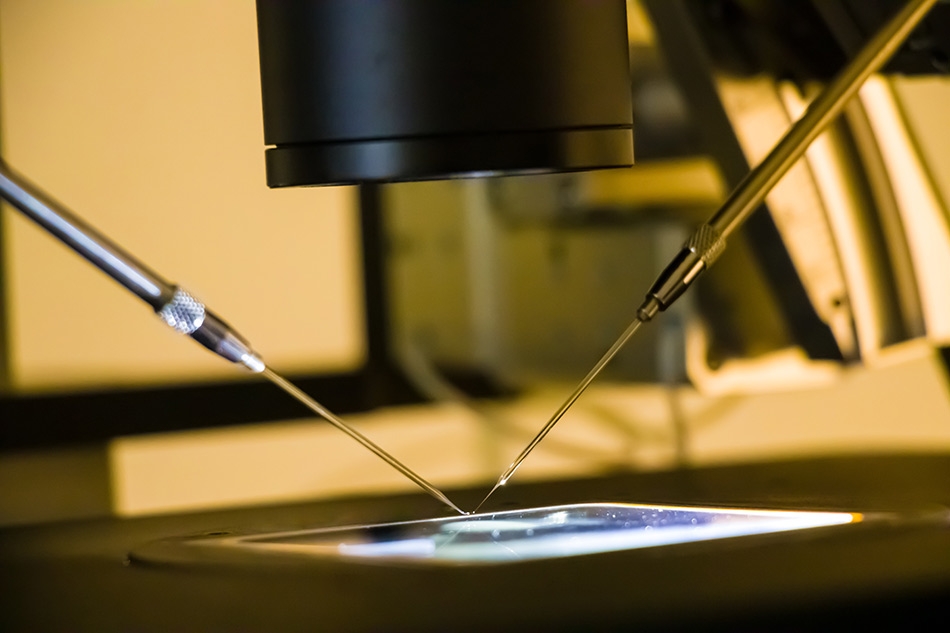
ICSI or intracytoplasmic sperm injection (ICSI) technology uses an injection pipette to inject sperm directly into the egg for fertilization. The most widely used ICSI technology in the world uses a sharp-tipped injection pipette to penetrate the zona pellucida surrounding the egg and injects the sperm into the egg. However, the sharp tip of the pipette cannot penetrate the egg’s cell membrane. Therefore, it is necessary to suck the egg’s cytoplasm into the injection pipette. During this process, the microstructure of the egg is deformed, which may affect the embryo’s development after fertilization.
Piezo ICSI is the latest technology that can minimize the disadvantages of conventional ICSI. The injection pipette has a flat end. Sucking of the egg’s cytoplasm is unnecessary because the injection pipette passes through the cell membrane with micro-electric vibrations created by electrical signals. As a result, physical damage and impact on the egg’s microstructure are minimized.Comparison of Piezo ICSI and Conventional ICSI
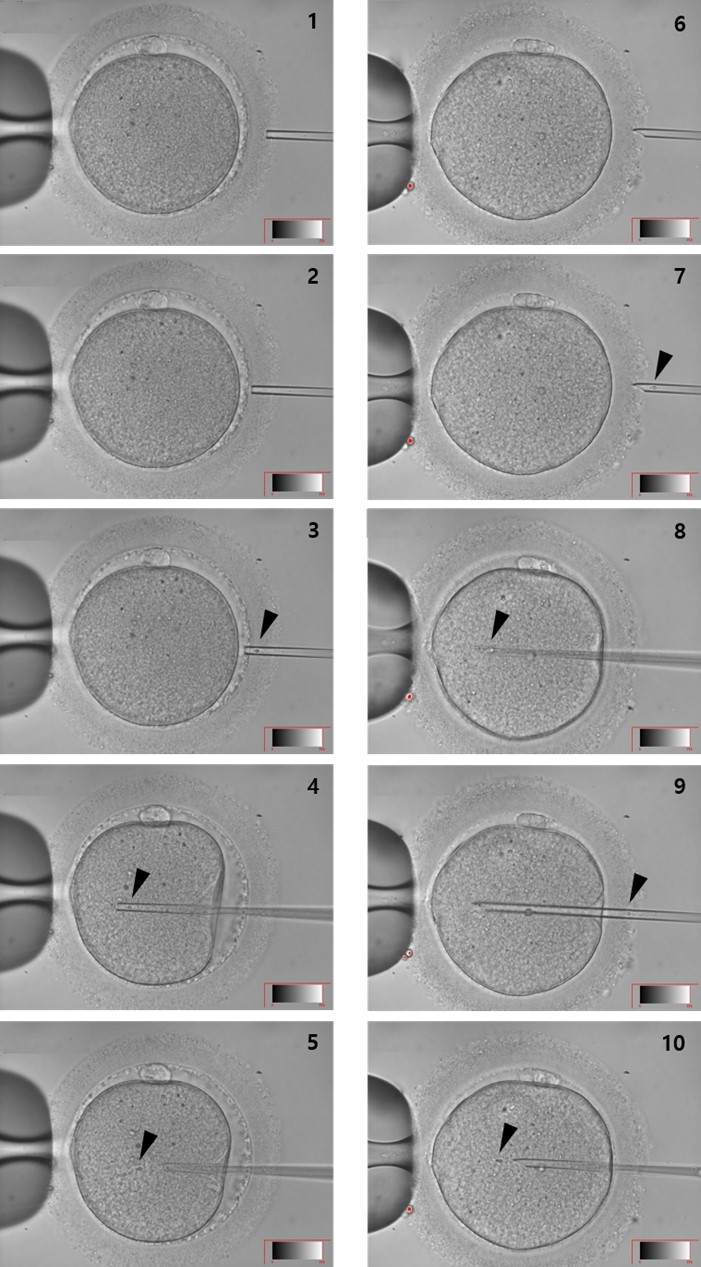
Piezo ICSI
- 1 Place a flat-tipped injection pipette close to the egg’s zona pellucida.
- 2 Penetrate the zona pellucida using micro-electric vibrations generated by electrical signals.
- 3 Gently pull the pipette out of the zona pellucida, remove the substances inside the pipette, place a sperm at the end of the pipette, and put it into the hole in the zona pellucida.
- 4 Penetrate the cell membrane by applying micro vibration once.
- 5 Pull the pipette back from the egg after injecting the sperm into the egg.
General ICSI
- 6 Place a sperm at the end of the injection pipette.
- 7 Penetrate the zona pellucida using a sharp-tipped injection pipette.
- 8 Suck the egg’s cytoplasm using the pipette to penetrate the egg’s cell membrane.
- 9 Inject sperm into the egg when its cell membrane is punctured.
- 10 Pull out the pipette from the egg.
When Is Piezo ICSI Used?
This new technology is used for patients who are older than 38 years of age, those who have failed egg fertilization in a previous cycle, or for those with significantly low fertilization rates. Other cases include when the conventional direct sperm injection method cannot be used because the egg’s cytoplasm layer is very thin, or the viscosity is too high.
Success Rate of Piezo ICSI Versus Conventional ICSI?
It is reported that the fertilization rate when using Piezo ICSI is 75-90%, about 10% higher than that of convention ICSI (64-83%). The survival rate of eggs when using Piezo ICSI is higher than in the other cases. This is probably because the Piezo ICSI does not suck the egg’s cytoplasm when passing through the zona pellucida and the cell membrane. Piezo ICSI can help generate more embryos than general ICSI, which raises the chances of getting quality embryos.
What Kind of Equipment Is Needed for Piezo ICSI?
Three pieces of equipment are needed to perform Piezo ICSI.
First, a polarized light microscope is needed to observe the egg spindle before performing Piezo ICSI. Spindle is a fibrous protein formed during the egg’s cell division. The spindle plays a key part in cell division by connecting the two poles and the chromosomes and separating the chromosomes. The location of a spindle differs by individual or egg. So, when performing Piezo ICSI, the exact location of the spindle should be observed to check where to inject the sperm. That is why a polarized light microscope is used during Piezo ICSI to check the location of the spindle and to avoid physical damage to the nucleus.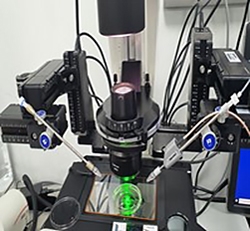 LC -Polscope Oosight – Hamilton
LC -Polscope Oosight – Hamilton
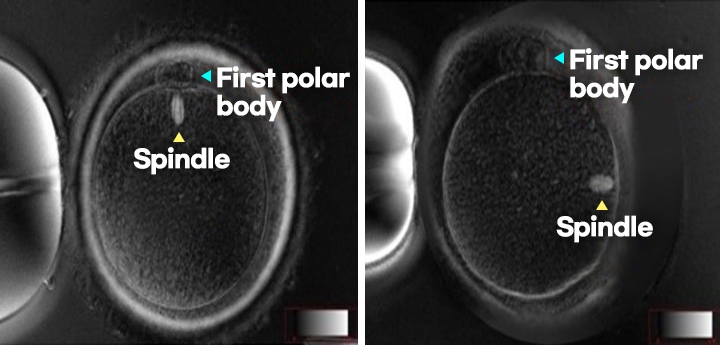 The location of the spindle is different for each egg.
The location of the spindle is different for each egg.
Second, PiezoXpert is needed to transmit electrical stimulation during Piezo ICSI. Unlike general ICSI, micro-electric vibrations are used on the egg, which is why this equipment is needed. It comprises of a control unit, a foot control, and an actuator.
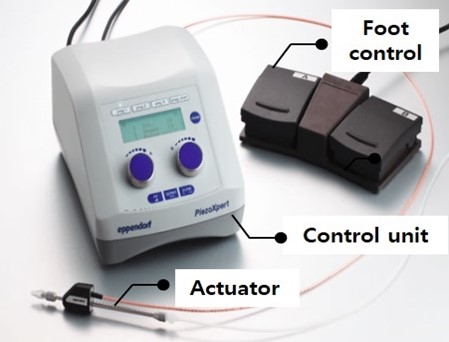 PiezoXpert
PiezoXpert
Third, a dedicated pipette is needed. A general ICSI pipette has a sharp end, as shown in the left photo below because it has to penetrate the zona pellucida and cytoplasm of the egg. On the other hand, the Piezo ICSI pipette seen in the right photo below has a flat end because it penetrates the zona pellucida and the cytoplasm with micro-electric vibrations. Also, a conventional ICSI pipette’s thickness is 1 μm, whereas the Piezo ICSI pipette is extremely thin (0.625 μm) to deliver micro-electric vibrations to the egg.
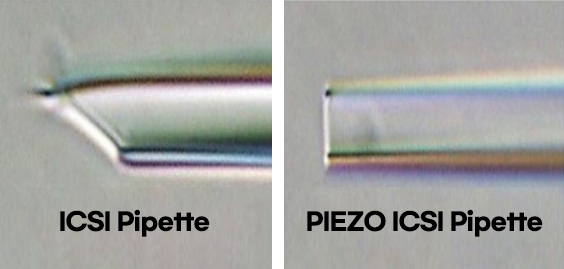 ICSI pipette / Piezo ICSI pipette
ICSI pipette / Piezo ICSI pipette
Success Cases of Becoming Pregnant After Using Piezo ICSI
1.Patient┃ A woman in her 20s
- Cause of infertility In this case the male had infertility problems. Sperm could not be collected on the day of egg collection, so the egg was frozen. The egg was thawed after extracting sperm from the testicular tissue to proceed with fertilization.
- Age When Egg Was Stored 23 years old
- Age When Piezo ICSI Was Performed 23 years old
- Result Seven frozen eggs were thawed, and six embryos were fertilized. Blastocyst embryos were implanted on the uterine wall and the patient became pregnant and gave birth successfully.
2. Patient┃ A woman in her 40s
- Cause of infertility The patient had problems with egg activation. She went through procedures several times, but no quality embryos were obtained.
- Age When Piezo ICSI Was Performed 44 years old
- Result Six embryos out of the nine eggs collected were fertilized using Piezo ICSI. Two of the embryos developed into blastocyst embryos and were implanted. The patient successfully became pregnant.
3. Patient ┃ An infertile woman in her 30s
- Cause of infertility In this case the male had infertility issues. His sperm condition was far from the normal range, so it was difficult to induce egg activation.
- Age When Piezo ICSI Was Performed 35 years old
- Result Activated the egg using Piezo ICSI. A blastocyst embryo was created, and the patient became pregnant successfully.
※ The above patient cases are from CHA University Ilsan Medical Center (http://ilsan.chamc.co.kr).
noteReviewed by Professor Se-yul Han, CHA Fertility Center at CHA University Ilsan Medical Center
Written by Reporter Jung-yoon Kim





